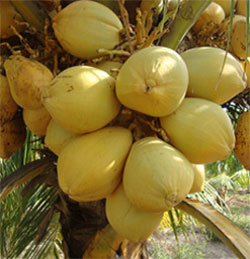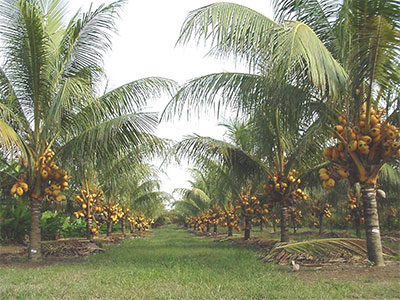EARLY seedling care is crucial and major emphasis should be placed on field maintenance. Irrigation and drainage is one aspect of field maintenance that needs special attention. It is important that rainfall be well distributed throughout the year for optimum coconut  production. Irrigation is necessary to provide sufficient soil moisture during dry periods to ensure good growth, development and yield.
production. Irrigation is necessary to provide sufficient soil moisture during dry periods to ensure good growth, development and yield.
An adult palm requires 600 to 800 litres of water once in four to seven days. Meanwhile, the production of female flowers and setting percentage increases significantly under irrigation. During periods of drought, there is high mortality of transplanted seedlings, shedding of young nuts, drying and hanging down of older fronds and, failure of young fronds to open.
During year one in the life of the young plant, irrigation should be done at a rate of 20 litres of water per plant per week; and, in the second year, 45 litres per plant once in four days. Basin irrigation is practiced by application of 200 litres of water once in four days to a shallow radial basin dug around the plant. In coastal sandy soils, seawater can be used for irrigation of palms older than two years.
Scarcity of water and increasing cost of labour and energy make drip irrigation a viable option to flood, basin or overhead sprinkler irrigation. Drip irrigation makes more efficient use of water, labour and energy. It enhances plant growth and yield and is most suitable for soils having a low water-holding capacity and undulating terrain. It reduces weed growth, improves efficiency of fertilizer use and facilitates fertigation. In coconut production, four drippers/emitters per tree are recommended. Water can be applied at the rate of 65-75 litres per palm per day during dry months. Field drainage should be conducted to remove excess soil moisture for proper tree development. A minimum of 50 cm of depth of well-drained soil should be maintained during wet periods.
Nutrition and Fertilization
Coconut palms require adequate nutrition during the early years. Young plants that receive fertilizer prior to flowering, grow faster, produce more and larger leaves, come into bearing earlier than unfertilized palms and, produce more and larger nuts. The most rapid growth occurs between the second and fifth years in the life of the coconut palm.
Supporting the crown is the stem and the latter grows 30 – 50 cm per year, up to about 40  years. Dry matter production is about 50 – 80 kg per year. In its prime, a coconut palm normally produces 12 – 15 leaves and about 80 – 100 water nuts per year.
years. Dry matter production is about 50 – 80 kg per year. In its prime, a coconut palm normally produces 12 – 15 leaves and about 80 – 100 water nuts per year.
Soils in old coconut plantations are expected to be impoverished if there was no fertilizer programme in place. Planting new and improved palms to replace old coconut groves makes very little sense if adequate nutrients are not supplied to the plants. Nitrogen is important in promoting leaf growth and development. Deficiencies in phosphorus retard palm growth and delay flowering. In potassium deficient soils, potassium fertilizers have a positive effect on the number of inflorescences, number of bunches and number of nuts per bunch, and total nut production.
Alternatively, instead of using 15-5-20, urea, triple super phosphate (TSP) and potash can be purchased and blended in the ratio (by weight): 3 urea: 1 TSP:3 potash. The Jamaica Coconut Industry Board recommends that fertilizer should not be placed in the planting hole because the planted seedling is still feeding on the endosperm. The body recommended that first application of fertilizer should be made three to six months after planting by which time active feeding roots will have developed.
Subsequent applications should be made at six-monthly intervals. The fertilizer must be spread over the zone where the active root tips occur. This zone stretches from the base of the palm to the limit of the leaf spread (Plate 33). During the first year, fertilizer should be applied in a circle 15 – 20 cm from the seedling stem. Subsequent applications should be made in wider circles as the roots grow outwards. For bearing trees, fertilizer should be spread about 2m from the base of the trunk. On sloping lands, the fertilizer should be incorporated to a depth of 15 cm at various points at the same radius as described previously.
Coconut husks are high in potash. Burying fresh or dried husks around the palm may reduce fertilizer cost through nutrient cycling. It can also increase retention of moisture and benefit drought-prone areas. For the placement of the husks, circular trenches may be dug 2m from the trunk, 0.5 m wide and at the same depth. The beneficial effect of husk burial was reported to last five to seven years. The application of fully decomposed farmyard manure, where available and economic, has also been found to be beneficial to the palms. However, it should be noted that the use of organic material can attract the Rhinoceros beetle.



.jpg)








